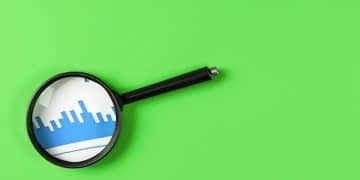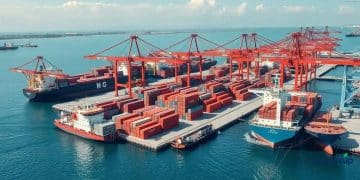Tariff-induced recession: what it means for the economy

A tariff-induced recession occurs when tariffs lead to decreased trade, increased consumer prices, and shifts in spending behavior, significantly impacting economic growth and consumer confidence.
Have you ever wondered how a tariff-induced recession could influence your daily life? As trade policies shift, the consequences can be profound and far-reaching. Let’s delve into what this means for you.
Understanding tariff-induced recession
Understanding a tariff-induced recession requires a look into how tariffs affect the economy at various levels. Tariffs are taxes imposed on imported goods, aiming to protect domestic industries but often causing unintended consequences. As trade policies shift, we see significant impacts on consumer prices and business operations.
The Mechanism of Tariffs
When tariffs rise, imported goods become more expensive. This can lead to higher prices for consumers as retailers often pass these costs on. Consequently, consumers may cut back on spending, which can slow down economic growth.
Economic Sectors Affected by Tariffs
Different sectors respond uniquely to tariff-induced recessions. Some industries may thrive, while others struggle to survive. Here are key sectors that often feel the effects:
- Manufacturing: Can see increased costs leading to layoffs.
- Agriculture: Export prices may drop, affecting profits.
- Retail: Higher prices can decrease customer spending.
- Services: May not be directly affected but can experience reduced demand.
The role of global supply chains also plays a significant part in how tariffs influence different industries. For example, companies relying on international components may face production delays and increased costs. This cascading effect can ripple through the economy, impacting jobs and growth.
Consumer Reactions
During a tariff-induced recession, consumer behavior changes significantly. People often become cautious, prioritizing essential purchases while postponing luxuries. This shift in spending habits can lead to lower sales for non-essential businesses, forcing them to adapt quickly to survive.
Furthermore, consumers may begin to support local products as a way to avoid high tariffs on imports. This behavior can help stimulate local economies even during tough times. For businesses, it becomes crucial to understand these shifts to adjust their marketing and product offerings accordingly.
Overall, understanding the implications of a tariff-induced recession is vital for both consumers and businesses. By recognizing the patterns and reactions within the economy, individuals can make more informed decisions.
Historical examples of tariff impacts

When discussing historical examples of tariff impacts, it’s essential to look at key events that shaped economies. Tariffs have been a major player in trade relations for centuries. They can stimulate growth in certain sectors while negatively affecting others.
The Smoot-Hawley Tariff Act
One of the most significant examples is the Smoot-Hawley Tariff Act of 1930. Initially designed to protect American farmers from foreign competition, the act raised tariffs on over 20,000 imported goods. This led to retaliation from other countries, resulting in a steep decline in international trade.
The Impact on the Great Depression
The repercussions were severe. As tariffs increased, global trade almost halved within a few years. This severely deepened the Great Depression. The act exemplifies how high tariffs can lead to economic turmoil rather than prosperity.
Post-World War II Tariff Policy
After World War II, many countries sought to rebuild and stabilize their economies through international trade agreements. The General Agreement on Tariffs and Trade (GATT) was established to reduce trade barriers. This shift showed that lower tariffs could promote economic recovery and intercountry cooperation.
China’s Accession to the World Trade Organization
An important moment in recent history was China’s accession to the World Trade Organization (WTO) in 2001. This entry led to decreases in tariffs on Chinese goods, resulting in a significant increase in exports. The outcome highlighted how tariffs can influence production and job markets globally.
Understanding these historical examples helps us grasp the complexities of tariff-induced changes in the economy. The impacts may vary across industries, but the overarching theme is clear: tariffs can drive significant economic shifts.
Sector-specific effects of tariffs
The effects of tariffs differ significantly across various sectors of the economy. Understanding these sector-specific effects of tariffs can illuminate how trade policies shape industries. Each sector reacts uniquely to tariff changes, reflecting its reliance on imports and the nature of its supply chains.
Manufacturing Sector
In the manufacturing sector, tariffs can lead to increased production costs. When raw materials are imported and tariffs rise, manufacturers face higher expenses. This often results in higher prices for consumers and can impact profit margins.
Agricultural Sector
The agricultural sector also experiences distinct impacts. Tariffs can protect domestic farmers by raising prices on foreign imports. However, they can also lead to retaliation from other countries, making it difficult for farmers to export their goods. For example, crops that rely heavily on exports may suffer when tariffs are imposed.
Retail Sector
In retail, tariffs on imported goods can lead to increased prices for consumers. Retailers may struggle to maintain their profit margins if they absorb the added costs. This can result in fewer choices for consumers and reduced sales during economic downturns.
Technological Sector
For the technology sector, tariffs on components can disrupt production. Many tech companies depend on international supply chains for critical parts. Increased tariffs can delay product launches and increase the pricing of gadgets, adversely affecting consumer demand.
Overall, while some sectors may benefit from tariffs, such as domestic producers, most face challenges that can hinder growth. Understanding these dynamics helps stakeholders make informed decisions in a changing economic landscape.
Consumer behavior during a recession

Consumer behavior changes significantly during a recession. Understanding consumer behavior during a recession is essential for businesses and policymakers. As the economy slows, people adjust their spending habits to manage tighter budgets.
Decreased Spending
One of the most noticeable changes is a decrease in discretionary spending. Consumers tend to prioritize essential items, such as food and healthcare, while cutting back on non-essential purchases. This shift can lead to reduced sales for many businesses that rely on luxury goods.
Increased Savings
During a recession, consumers often feel uncertain about their financial futures. As a result, many begin to increase their savings. They may seek to build an emergency fund to prepare for potential job loss or unexpected expenses. This behavior ultimately contributes to lower spending across the economy.
Shift in Brand Loyalty
As people become more price-conscious, brand loyalty may waver. Consumers might start exploring cheaper alternatives or generic brands to save money. This change can force established brands to reevaluate their pricing strategies and marketing approaches.
- People may switch to discount retailers.
- More consumers search for sales and promotions.
- Brand perception can change based on economic factors.
Furthermore, online shopping tends to increase during a recession. Consumers often hunt for the best deals, and the convenience of online shopping makes it easier to compare prices. The use of mobile apps and websites for discounts becomes commonplace as people look for ways to stretch their budgets.
Understanding these shifts in consumer behavior can help businesses adapt their strategies. By recognizing the importance of price sensitivity and changing preferences, companies can align their offerings with the needs of consumers during tough economic times.
Strategies for adapting to economic changes
Adapting to economic changes is crucial for businesses to thrive. Implementing effective strategies for adapting to economic changes can ensure sustainability and growth, even during challenging times.
Understanding Market Trends
One key strategy involves closely monitoring market trends. Businesses should analyze consumer behavior and competition to understand shifts in the marketplace. Knowing when to pivot or adjust product offerings can make a significant difference in sales.
Enhancing Flexibility
Flexibility is another vital element. Companies should develop systems that allow quick adjustments to production processes and inventory levels. This way, they can respond swiftly to changes in demand or supply chain disruptions.
- Adopt lean manufacturing techniques.
- Utilize just-in-time inventory systems.
- Foster a culture of innovation within the organization.
Financial Management
Sound financial management becomes even more critical during economic fluctuations. Businesses should focus on maintaining healthy cash flow, reducing expenses where possible, and exploring new revenue streams. Creating a financial cushion can provide peace of mind during economic uncertainty.
Investing in technology can be a game-changer. Implementing new tools can streamline operations, reduce costs, and improve customer engagement. Embracing online sales channels can also help businesses reach a broader audience, adapting their sales strategies to current consumer habits.
Another strategy is strengthening customer relationships. Engaging with customers through feedback can help businesses align their offerings more closely with consumer needs. Strong communication fosters loyalty, making it easier to retain customers during tough economic times.
Lastly, networking with other businesses can provide valuable insights and support. Collaborating can lead to innovative solutions and shared resources, which is especially important in times of financial strain.
In summary, understanding economic changes is key to business success
Adapting to shifts in the economy requires a proactive approach. Businesses that monitor market trends, enhance flexibility, and manage finances wisely are better equipped to thrive.
Moreover, investing in technology and strengthening customer relationships can foster loyalty and drive growth. By collaborating with other businesses and sharing resources, companies can navigate challenges together.
Ultimately, being prepared and willing to adapt is essential for long-term success. Embracing change can open up new opportunities and ensure a stronger future for businesses in any economic climate.
FAQ – Frequently Asked Questions about Adapting to Economic Changes
How can monitoring market trends help my business during economic changes?
Monitoring market trends allows you to understand shifts in consumer behavior and adjust your strategies accordingly, ensuring your business stays relevant and competitive.
What are some effective financial management tips for a recession?
Effective tips include maintaining a healthy cash flow, reducing unnecessary expenses, and exploring new revenue streams to ensure financial stability.
How can technology improve my business’s adaptability?
Investing in technology can streamline operations, reduce costs, and enhance customer engagement, making it easier to adapt to changing market conditions.
Why is customer feedback important during economic changes?
Customer feedback helps you understand their needs and preferences, allowing you to adjust your offerings and build loyalty even during tough times.





